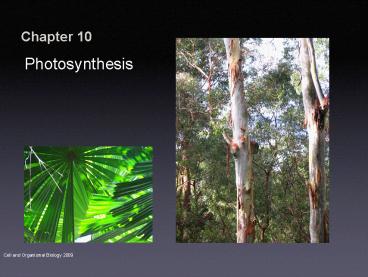Photosynthesis - PowerPoint PPT Presentation
1 / 44
Title:
Photosynthesis
Description:
Redox involves loss or gain of a hydrogen atom or an electron. C6H12O6 6O2 ... in photosynthesis: absorption and action spectra for photosynthesis in an alga ... – PowerPoint PPT presentation
Number of Views:35
Avg rating:3.0/5.0
Title: Photosynthesis
1
Chapter 10
- Photosynthesis
2
Figure 10.1 Photoautotrophs
3
REDOX in Respiration
- Redox involves loss or gain of a hydrogen atom or
an electron - C6H12O6 6O2 ---gt 6CO2 6H2O
- Energy given off as ATP
- Carbon loses hydrogen therefore is oxidized.
- Oxygen gains hydrogen therefore is reduced.
4
REDOX in Photosynthesis
- Redox involves loss or gain of a hydrogen atom or
an electron - 6CO2 6H2O ---gt C6H12O6 6O2
- Energy supplied by light
- Carbon gains hydrogen therefore is reduced.
- Oxygen loses hydrogen therefore is oxidized.
5
Figure 10.3 Focusing in on the location of
photosynthesis in a plant
6
Two parts to photosynthesis
Melvin Calvin
- Light-dependent reactions (light) LDRs
- Light-independent reactions (dark) LIRs
7
Figure 10.5 An overview of photosynthesis
cooperation of the light reactions and the Calvin
cycle (Layer 1)
8
Figure 10.5 An overview of photosynthesis
cooperation of the light reactions and the Calvin
cycle (Layer 2)
- ATP
- Nicotinamide Adenine Dinucleotide Phosphate
(NADPH) - NADP H 2e- -------gt NADPH
- Oxidized form Reduced form
9
Figure 10.5 An overview of photosynthesis
cooperation of the light reactions and the Calvin
cycle (Layer 3)
10
Factors limiting photosynthesis
- 1. Light intensity (LDRs)
- 2. Substrates (LIRs)
- Low CO2 affects rate directly
- Low water affects rate indirectly by closing
stomata - 3. Temperature (LIRs)
- 4. Photorespiration (LIRs)
11
Figure 10.6 The electromagnetic spectrum
12
Figure 10.7 Determining an absorption spectrum
13
Figure 10.9 Evidence that chloroplast pigments
participate in photosynthesis absorption and
action spectra for photosynthesis in an alga
14
Figure 10.10 Location and structure of
chlorophyll molecules in plants
15
(No Transcript)
16
Accessory Pigments
- Carotene
- Found in
17
Figure 10.11 Excitation of isolated chlorophyll
by light
18
Chlorophyll molecules work in Photosystems
19
Photosystem 1
- 96 Chlorophyll molecules
- 22 Carotinoids
- 4 Lipids
- 2 Phytoquinones
- 3 Iron Sulphate clusters
- Lots of proteins
PSII p680 PSI p700
20
Photosystem 1
21
- Photosystem Reaction Center
- PRC chlorophyll donates electrons to acceptor
- Oxidized photosystem then grabs electrons
(oxidizes) from electron donor (water)
22
High Energy Shuttles
- ATP
- Nicotinamide Adenine Dinucleotide Phosphate
(NADPH) - NADP H 2e- -------gt NADPH
- Oxidized form Reduced form
23
Two types of photosynthesis
- Non-cyclic photophosphorylation
- Z-scheme
- Plants
- Makes ATP and NADPH
- Cyclic photophosphorylation
- Plants and bacteria
- Makes ATP
24
Figure 10.13 How noncyclic electron flow during
the light reactions generates ATP and NADPH
(Layer 1)
25
Figure 10.13 How noncyclic electron flow during
the light reactions generates ATP and NADPH
(Layer 2)
26
Figure 10.13 How noncyclic electron flow during
the light reactions generates ATP and NADPH
(Layer 3)
27
Figure 10.13 How noncyclic electron flow during
the light reactions generates ATP and NADPH
(Layer 4)
28
Figure 10.12 How noncyclic electron flow during
the light reactions generates ATP and NADPH
(Layer 5)
29
P680
P700
30
Figure 10.15 Cyclic electron flow Cyclic
photophosphorylation
31
Figure 10.16 Comparison of chemiosmosis in
mitochondria and chloroplasts
32
Figure 10.17 The light reactions and
chemiosmosis the organization of the thylakoid
membrane
33
Now What?
- ATP and NADPH made during light-dependent
reactions - These high-energy shuttles used in the
light-independent reactions to make glucose
34
C3
First step in carbon fixation
Ribulose Bisphosphate Carboxylase/ Oxygenase
(RUBISCO)
35
Figure 10.17 The Calvin cycle (Layer 1)
36
Figure 10.18 The Calvin cycle (Layer 2)
37
Figure 10.18 The Calvin cycle (Layer 3)
38
Photorespiration Ribulose Bisphosphate
Carboxylase/ Oxygenase (RUBISCO)
- Problem High O2 oxidizes RuBP to produce CO2
with no ATP or NADPH synthesis. At 25oC, PR
oxidizes 20 of fixed carbon. WASTE - Problem This Photorespiration speeds up at high
temperatures. Carbon fixation does not increase.
BIG WASTE - Solution C4 Photosynthesis (C4 and CAM plants)
39
C4 and Crassulacean Acid Metabolism
- C4
- Separates RUBISCO from high levels of oxygen
physically - CAM
- Separates RUBISCO from high levels of oxygen
temporally
40
Figure 10.19 C4 leaf anatomy and the C4 pathway
41
(No Transcript)
42
Figure 10.19 C4 and CAM photosynthesis compared
43
Figure 10.20 A review of photosynthesis
44
Figure 9.1 Energy flow and chemical recycling in
ecosystems































